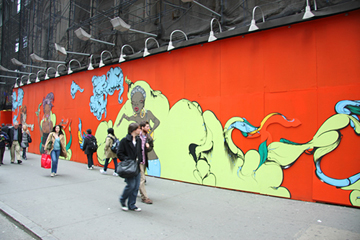Do artists from underrepresented demographic groups have a responsibility to represent their ethnicity in a positive light? This is not a new question, in fact, it seems to re-enter the national conversation every time a minority artist ventures to create a provocative image. This question has recently reemerged in response to Sofia Maldonado’s mural installed near Times Square. As reported on CNN, the local Fox affiliate, the New York Times and several popular blogs, Maldonado’s work has come under fire because some viewers find her representation of the women of color in her mural—scantily clad with long acrylic fingernails—inappropriate. Furthermore, as reported by Jezebel, a feminist blog, at least one minority group, New York City Black Professionals, condemns the mural noting that, “this is not even about the Latina artist [Maldonado is of Puerto-Rican and Cuban descent] or her expression of how she sees NY; she was only painting what they [the Times Square Alliance] commissioned her to do in order to get her paycheck…and the end result was a slap in the face of every woman of black and brown descent.”
This question of “responsible” representation is not unique to the visual arts. Over the years, African-American rappers, such as Ice-T and DMX, have been lambasted for their hyper-masculine, misogynistic lyrics. Stephenie Meyer, the author of the wildly successful Twilight series, has been roundly criticized by feminist scholars for creating a heroine, Bella, who is devoid of all personality and lives only for her boyfriend.
The problem with this question is that it aims to reduce artistic expression into a Manichean dichotomy of good and bad, acceptable and offensive. The very supposition of responsibility removes the essential subjectivity from the creation and viewing of art. An African-American woman in the Fox 5 News piece on Maldonado’s mural condemns the work because, “that’s not who we are.” Maldonado would agree. In all of the statements she has given about her mural, she has never presented her work as representative of all women of color. Her most widely quoted statement makes this clear; Maldonado wrote on her blog that her mural “illustrates strong New York City women as a tribute to the Caribbean experience in America. Inspired by my heritage, it illustrates a female aesthetic that is not usually represented in media or fashion advertising in Times Square.” Maldonado’s mural depicts a segment of the Caribbean-American population. It may be a segment that some viewers would consider “ghetto,” as another person interviewed by Fox put it, but it is not a segment ever intended to represent the entire ethnic group.
So why this confusion? Why do some viewers of subjective, specific pieces like Maldonado’s have this immediate, offended reaction? As African-American blogger Keysha Whitacker explained, people of color are concerned that “good white folks” will see “our shame.” She further admonishes people of color to stop trying to “manage” how they are viewed by other racial groups.
This desire to only present a positive face to the rest of the world is understandable, but also impossible. For one, who gets to decide which images of ethnic groups should be propagated? Government officials? Advocacy groups like the NAACP or LULAC? Curators? And second, which artists would be sanctioned as appropriate? Should Kehinde Wiley’s rappers and African youths be solely representative of the black experience? What about the work of Yinka Shonibare, Lorna Simpson, or Kara Walker? Walker’s art, in particular, is provocative and many times vitriolic, frequently centering on stereotypical depictions of African-American slaves. Should her work, displayed in museums throughout the world, be banned from public spaces because it dwells on a shameful period in American history?
Moreover, the suggestion that there exists a correct and acceptable depiction of an ethnic group smacks of fascism. In reading and hearing people’s suggestions on how Maldonado should be representing women of color, in business suits and carrying briefcases, I was reminded of the official art programs in Nazi Germany and Communist Russia. By enforcing strict propaganda programs, these countries did not succeed in changing the world’s view of their regimes; they only succeeded in encouraging spiritless, mediocre art.
There is no singular and representative African-American experience or Latina experience—just as there is no singular and representative European-American experience. The world is made up of an infinite variety of people with myriad identities and experiences. Regardless of whether or not an artist comes from an underrepresented ethnic group, he or she should be allowed to express and represent him- or herself in any way he or she sees fit. We as viewers and audience members must, in turn, be willing to evaluate art solely on its own merits and not on our preconceived notions of ethnic identity.
Anna Daley is editor of the Gallery Crawl website and based in New York City.



